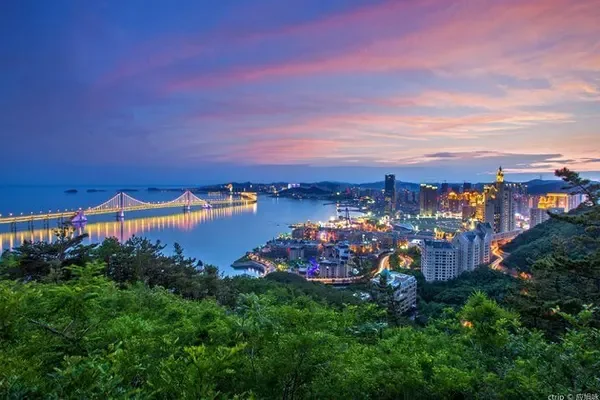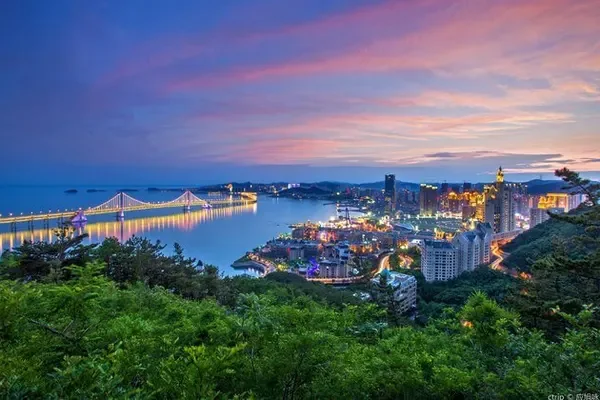"2020 Self-Driving Westward Journey Part One: Lingbi Xuchang Sanmenxia Chapter"
This is the sequel: Part 2: Yuncheng Chapter
Day 7, April 19,
From Hangu Pass in Sanmenxia, Henan to Guandi Temple in Jiezhou, Yuncheng, Shanxi: 48 kilometers, 50 minutes;
To Yuncheng City: 24, 0:40
Live in Yuncheng City.
1. Jiezhou Guandi Temple: Tickets are 60 yuan/person.
It is the ancestor of Wu Temple, located in Xiguan, Xiezhou Town, Yuncheng City, Shanxi Province. To the north is Yanchi, facing Zhongtiao.
Jiezhou Guandi Temple was founded in the ninth year of Emperor Kaihuang (589) in the Sui Dynasty. It was expanded and rebuilt in the Song and Ming Dynasties.
Jiezhou Guandi Temple has a total area of 220,000 square meters and more than 200 houses. It is divided into two parts: the main temple and the Jieyi Garden. It is the largest existing palace-style Taoist building complex and Wu Temple. ", "Crown of Wu Temple".
Hanging in the temple are plaques such as "Yi Bing Qian Kun" written by Emperor Kangxi, "Shen Yong" imperially appointed by Qianlong, "Wan Shi Ren Ji" written by Xianfeng, and "Wei Ling Zhen Die" written by Empress Dowager Cixi. The representative building is "Spring and Autumn Building".
Xiezhou Guandi Temple Scenic Spot is a national key cultural relic protection unit and a national AAAA-level tourist attraction. "Guan Gong Belief and Custom" has been included in the national intangible cultural heritage list, and "Guan Gong Cultural Festival" has been rated as one of China's top ten festivals for people. In 2012, the "Guansheng Cultural Building Complex" was included in the China World Cultural Heritage Preparatory List.













































































2. Changping Guandi Temple: Tickets 30/person, parking 10.
Changping Guandi Ancestral Temple, commonly known as Guan Yu Family Temple, is located in Changping Village, Changping Township.





















Changping Guandi Temple is a family temple. The managers may all be villagers. Although they wear uniforms, they are still villagers when they talk and do things.

Guan Gong sculpture on the mountain in the distance.
3. Salt Lake: 4A.
Yuncheng Salt Lake is one of the three largest sodium sulfate inland salt lakes in the world. Because its salt content is similar to the "Dead Sea" in the Middle East, people can float in the water without sinking, so it is known as "China's Dead Sea".
Yuncheng Salt Lake is an ancient and typical inland saltwater lake. Geological research shows that Yuncheng Salt Lake was born in the Cenozoic Tertiary Himalayan tectonic movement period, with a history of about 50 million years. It extends from northeast to southwest, about 30 kilometers long and wide. 3 kilometers to 5 kilometers, the lake surface is 324.5 meters above sea level, the deepest part is about 6 meters, and the total area is 132 square kilometers.
I rented an electric car for 30 yuan, drove in and went around for half an hour.




























4. Pool Temple:
It's too late, so I won't let you in. The following Monday, the museum is closed.
The Yanchi Temple was built in 777, the 12th year of Dali in Tang Dynasty. Emperor Li Yu of Tang Dynasty bestowed Yanchi in Yuncheng as "Baoying Lingqing Pond", ordered a temple to be built in Yanchi, and conferred the title of "Lingqing Gong" on the god of the pool. Included in the national sacrificial ceremony.
It is the only temple in the country that worships the God of Pond, the God of the Sun and the God of Wind at the same time.


Day 8, Monday, April 20, Yuncheng
5. Guanwang Temple: No. 192 Fenghuang Road / No. 61 Hongqi West Street
Founded in the Yuan Dynasty, it was overhauled in the sixth year of Ming Zhengde (1511) and the fifth year of Jiajing (1526).
The temple site faces east and west, and there are existing mountain gates, dedicated halls, main halls and spring and autumn buildings. The gate, the hall of sacrifice and the main hall are all buildings of the Ming Dynasty.













6. Catholic Church: Opposite Guanwang Temple

7. Mausoleum of Emperor Shun:
Beixiang Town, Salt Lake District, free, shuttle bus 10/person.
The Mausoleum of Emperor Shun is located at the west end of Mingtiaogang, Yuncheng City, Shanxi Province. It is the mausoleum of Emperor Shun, one of the "Five Emperors" of the Chinese nation. In May 2006, it was announced by the State Council as a national key cultural relic protection unit and a national AAAA-level scenic spot. It is divided into four parts: Shundi Avenue, Shundi Square, Shundi Park and Shundi Mausoleum.
The mausoleum was opened in the time of Yu Yu, and the mausoleum temple was built in the 26th year of Tang Kaiyuan (738).
The Mausoleum of Emperor Shun covers an area of 1778 mu, which is divided into scenic area and mausoleum area. The scenic spot is composed of Emperor Shun Square, Shinto, Hundred Gardens, Botanical Garden, Lishan Mountain, Tiaogu Cangye, Lei Ze Lake, Guirui River, playground, and Monkey Mountain.
In the scenic area, there are verdant pines and cypresses, a hundred flowers blooming, sparkling waves, and roads. The landscape water system runs through the north and south, and the four arch bridges of Gao, Kui, Ji and Qi complement each other with the scenery of lakes and mountains, all of which demonstrate the wisdom of the northern garden builders.
There are 4,000-year-old cypresses.





4,000-year-old Cooper:





















From Mausoleum of Emperor Yu in Yuncheng to Li Family Courtyard in Wanrong County: 34 kilometers, 0:36;
8. Li Family Courtyard: Tickets 30/person (half price), parking 10
It was the house used by Li Zi, the richest man in southern Shanxi from the Qing Dynasty to the Republic of China.
Founded in the Daoguang period of the Qing Dynasty, it is located in Yanjing Village, Wanrong County. Together with the Qiao Family Courtyard and the Wang Family Courtyard, it is also known as "Shanxi Merchants Sandilian". Good" said.
The overall building is a shaft-style Shanxi quadrangle that gathers wealth. At the same time, it absorbs the Hui-style architectural style. Because Li Ziyong once studied in the UK, some courtyards are "Gothic" buildings. The Shangyuan, which condenses the profound heritage of Han traditional culture, has extremely high cultural and artistic value.
The Li Family Courtyard Scenic Spot is 38 kilometers away from the urban area of Yuncheng City. It is a national AAAA-level tourist attraction and a national key cultural relic protection unit. There are 20 groups of original courtyards and 280 houses, and 11 groups of existing courtyards and 146 houses.
I heard that during the Cultural Revolution, this place was used as a school, so it is better protected.







































































































Li Family Courtyard to Wanrong County: 35 kilometers, half an hour.
9. Wanrong Dongyue Temple:
It is a Chinese Taoist building. In Wanrong County, Shanxi Province (Gujiedian Town). It is unknown when it was founded, but it existed during the Zhenguan period of Tang Dynasty (627-649), was rebuilt from the 28th year of the Yuan Dynasty to the first year of Dade (1291-1297), and was expanded and repaired in the Ming and Qing Dynasties.
Wanrong Dongyue Temple, the main buildings are Feiyun Tower, Meridian Gate, Xiandian, Xiangting, Tianqi Great Emperor Hall and bedroom. Among them, the Feiyun Building is beautiful in shape and ingenious in structure combination, giving full play to the strengths of Chinese architectural techniques. It is a rare material in the existing ancient buildings.
Feiyun Building: Located in Dongyue Temple, Wanrong County, Shanxi Province, it is a pure wooden structure and is known as "the first wooden building in China". Feiyun Building is a Yuan and Ming style building with a height of 23.19 meters. The whole building is densely covered with bucket arches, exquisite and exquisite. It is also called "South Tower and North Tower" together with Yingxian Wooden Pagoda. It is a national key cultural relics protection unit.
























Live in Wanrong County.
Day 9, April 21
From Wanrong County, Yuncheng, Shanxi to Hancheng, Weinan, Shaanxi, passing Dayu Temple, Hejin City, Shanxi:








Next, cross the Yellow River from Hejin, Yuncheng, Shanxi to Hancheng, Weinan, Shaanxi. Please pay attention to: 2020 Self-driving Westward Journey III: Hancheng Sanyuan Xianyang Baoji Chapter.
This is my 22nd travel note, I hope it will be helpful to travelers! Please criticize and correct!
Don't forget to like if you like it!


